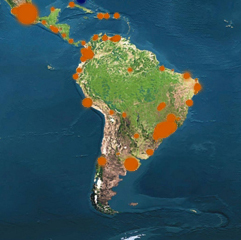2. Urbanisation
Middle and South America

Latin America and the Caribbean were 50% urbanised by 1960 but are now in the region of 75%, a level of urbanization comparable to that of Europe. There is also a heavy concentration of population in large cities, in 1990, more people were living in 'million cities' in the region than in rural areas (Pacione 2001, UN-HABITAT 2001).
The rapid urbanisation is related to the scale of economic growth in the countries. For example Brazil, Mexico, Colombia and the Dominican Republic are experiencing both rapid economic growth and high levels of urbanisation.
- The most urbanised countries in this region with over 80% of their population in urban areas include Venezuela, Argentina, Chile and Uruguay with a long tradition of urban development.
- Countries with urbanisation rates between 50 and 80% experienced rapid urban and economic development in the last 50 years and include Brazil, Mexico, Colombia, Ecuador, the Dominican Republic, Bolivia, Peru and Trinidad and Tobago.
- The least urbanised countries in this region with less than 50% of the population living in urban areas comprise of less populous countries such as Paraguay, Haiti and Costa Rica (Pacione 2001).
In 2000, Latin America and the Caribbean had 400 million urban dwellers of which 41.8% lived in the region's 50 'million cities'. 15.1% of the total regional population and 61.5% of its urban population lived in cities exceeding 5 million people (UN-HABITAT 2001).
Most of the urban centres today were founded by the Spanish and Portuguese, some such as Mexico City and Quito being even older pre-Colombian cities (before the colonialisation) (Pacione 2001).
All major metropolitan areas experience a decentralisation and suburbanisation of population and production as they grow. A study of Latin American cities during the 1970s found that nine of the ten largest cities were all experiencing rapid growth on the periphery, but at the same time, large cities have also increased in density (Pacione 2001, UN-HABITAT 2001).
In many of the higher-income countries in Latin America the factors that stimulated urban decentralisation in North America and Europe like the development of good-quality interregional transport and communication systems, will also influence the urban structure in Latin America and the Caribbean (Pacione 2001).
Tasks: 1. Describe the urbanisation process in this region.
2. Identify the drivers of urbanisation.
3. Try to estimate the consequences of the processes of separation, increase of poor settlements and suburbanisation for Latin America and the Caribbean.
Case study: Mexico City

